
Rule changes on Yucata:
- Scoring games are played in two legs; once as dragon, once as dwarves.
- Dragon player is determined randomly for the first leg.
- The number of wounds given to your opponent is used as tie breaker over both legs.
Introduction
In the game Drako, one player leads a team of three dwarves, whose purpose is to defeat the dragon. This must be done within a certain time - before the player’s deck of cards runs out - to win the game. Each dwarf has his own characteristics and skills.
The second player directs the dragon, whose purpose is to survive or to defeat the dwarves. If the dwarves’ deck is exhausted, the dragon flies away, and the dragon player wins. The dragon player can also win by defeating all the dwarves (although this happens quite rarely, because the dragon is weakened and trapped in a small area).
Contents
Game components
- board of the valley (1)
- 25 wound markers (2)
Pieces for the dragon player
- dragon player mat (3)
- 1 dragon figure (4)
- deck of 38 dragon cards (5)
Pieces for the dwarf player
- dwarf player mat (7)
- deck of 38 dwarf cards (8)
- net & fury marker (10)
- 3 dwarf figures (11)
|
Setup
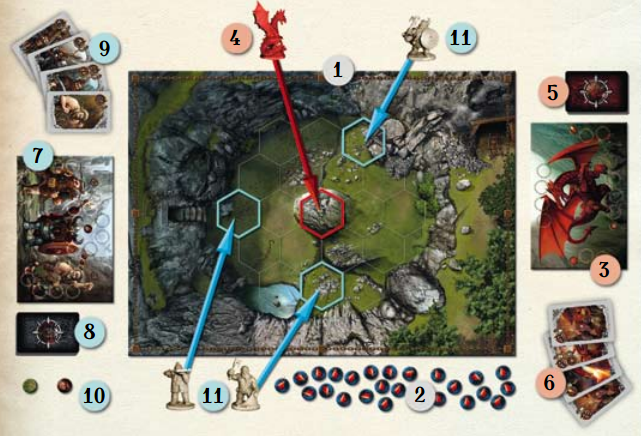
|
Place the board in the middle of the table (1), with wound markers nearby (2), so that both players have easy access to them.
The dragon player sets up the dragon pieces - the player mat goes in front of the player (3), the dragon figure goes on the middle of the board (4), and the dragon cards are shuffled and placed face down in a stack (5).
Then he draws 4 cards from the deck and looks at them - they are his starting hand (6).
The dwarf player sets up the dwarf pieces - the player mat goes in front of the player (7), and the dwarf cards are shuffled and placed face down in a stack (8).
Then he draws 4 cards from the deck and looks at them - they are his starting hand (9). The net and fury markers should be placed near the dwarf player mat (10).
If you are playing for the first time, place the dwarf figures as shown in the picture (11).
In subsequent games, the dwarf player, after looking at their starting hand, may place the dwarf figures on any of the board hexes not adjacent to the dragon - depending on the player’s strategy plans.
Advanced rule: If you want to have more control over the game, each player may exchange their entire starting hand once, before play begins. The first starting hand is shuffled back into the deck, then 4 new cards are drawn.
Game Play
Players take their turns one after the other, starting with the dragon player.
In the first turn, the dragon player performs only one action. In every later turn, players perform 2 actions.
The possible actions are:
Actions can be freely combined, i.e., a player can draw 2 cards and play 1, or play 1 card and draw 2, or play 2 cards, or draw 4 cards. The player must perform two actions - passing an action is not allowed.
The only exception is a situation which can happen at the end of the game, if the dwarf player still has cards and the dragon player does not. Then the dragon player passes and waits for the results of the opponent’s moves.
Drawing 2 cards
The player draws 2 cards from his deck and adds them to his hand. There is a hand limit of 6. If a player has more than 6 cards after drawing 2 cards, then the player must discard down to 6.
Playing 1 card
The player plays a card from his hand and chooses to use one of the options presented symbolically in the upper left corner of the card.
After playing a card, it is discarded from the game.
Most of the symbols allow a move or an attack, as described below.
Move
By playing a card to move, a player can make one (or possibly more) of his figures move up to as many hexes as the card’s movement points (the number next to the symbol). Not all movement points must be used; it is even legal to not move at all. (The card is still discarded.)
Attack
By playing a card to attack, a player can make one (or possibly more) of his figures attack with the card’s attack value (the number next to the symbol).
If a player plays a card to attack, the opponent may immediately respond by playing a card with a defense symbol (which does not count as one of the player’s 2 actions). This blocks the attack (and both cards are discarded).
If the attack is successful (not blocked), the target figure takes damage - place as many wound markers as the card’s attack value onto the owner’s player mat. If a dwarf is attacked, the wound markers go onto that specific dwarf’s space on the player mat.
If the dragon is attacked, the 4 dragon’s armor spaces receive the first 4 wounds. Then the dwarf player decides where later wound markers are placed (on spaces representing various abilities). If all spaces for a given ability are wounded, the dragon cannot use that ability.
After all of a figure’s spaces are wounded, the figure is killed and removed from the board.
SYMBOLS ON THE DWARF CARDS
 |
1 dwarf moves |
1 dwarf can move up to as many hexes as the card’s movement value. |
 |
2 dwarves move |
1 or 2 dwarves can move, each up to as many hexes as the card’s movement value. |
 |
1 dwarf attacks |
1 dwarf adjacent to the dragon can attack the dragon, using the card’s attack value. The attack can be blocked by a defense card. |
 |
2 dwarves attack |
1 or 2 dwarves adjacent to the dragon can each attack the dragon simultaneously, each using the card’s attack value. The dragon can play 1 or 2 defense cards to block 1 or both attacks. |
 |
Defense |
This can block a single attack by the dragon. |
 |
Crossbow attack |
If the dwarf with the archery ability is in a straight line of hexes with the dragon, with no other dwarf between them, then the dwarf can shoot the dragon using the card’s attack value. The attack can be blocked by a defense card. |
 |
Net |
If the dwarf with the net ability is still alive, he may immobilize the dragon. The dwarf can do this from anywhere on the board. He puts the net marker onto the dragon. While netted, the dragon can not move (flying or walking), but can attack and defend. To escape free of the net, the dragon player must spend 2 actions in a single turn doing nothing else (effectively passing a turn). (The net may then be used again later.) The net cannot be blocked by a defense card. |
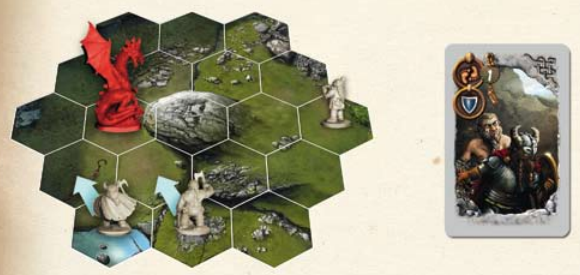
Example: John draws 2 cards as his first action, then plays a card with the
“2 dwarves move” symbol in order to move 2 dwarves one hex each toward the
dragon.
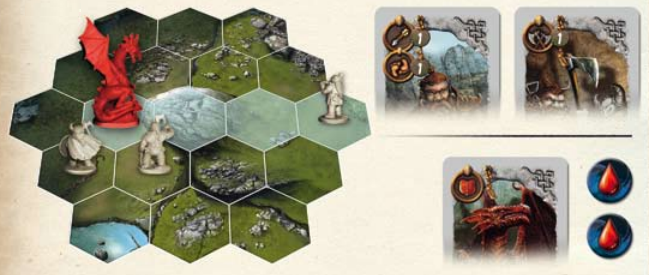
Example: On a later turn, John plays a card with the “Crossbow attack” symbol. His dwarf with the archery ability is in a hex row with the dragon, so he can shoot. Kate, the dragon player, plays a defense card in reaction to this attack, so the dragon receives no wounds, and both cards are discarded.
Then John plays another card, with the “2 dwarves attack” symbol, so that his 2 dwarves adjacent to the dragon can attack. Kate has no more defense cards, and so both attacks succeed - the dragon receives 2 wounds.
DWARF PLAYER MAT AND ABILITIES
The dwarf player has three unique characters with different abilities. During the game, wound markers will be placed on the corresponding spaces of the dwarf who was attacked.
Each dwarf has a different number of wound spaces. If all of a dwarf’s spaces are wounded, the dwarf is killed and removed from the board. If all 3 dwarves are killed, the dwarves are defeated and the dwarf player loses the game.
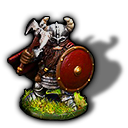 |
Fury |
Once during the game, this dwarf may declare a Fury turn. This dwarf receives a wound marker, and then the dwarf player can perform 3 actions instead of the normal 2. The 3 actions may be done by any dwarves as usual. After the Fury turn, the player discards his Fury marker to note that Fury cannot be done again during the game. |
 |
Archery |
This dwarf may use a card with the Crossbow attack symbol to attack the dragon from far away if they are in the same line of hexes. |
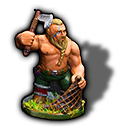 |
Net |
This dwarf may use a card with the Net symbol to immobilize the dragon. |
SYMBOLS ON THE DRAGON CARDS
 |
Move |
The dragon can move up to as many hexes as the card’s movement value (if the dragon can walk). |
 |
Flight |
The dragon can move to any empty hex on the board (if the dragon can fly). |
 |
Attack |
The dragon can attack an adjacent dwarf, using the card’s attack value. The attack can be blocked by a defense card. |
 |
Fire attack |
The dragon can breathe fire in a straight line of hexes in one of the 6 directions (if the dragon can breathe fire). All the dwarves in the line of attack each take damage equal to the card’s attack value. The attack can be blocked by one or more defense cards - each defense card protects one dwarf. |
 |
Defense |
This can block a single attack by the dwarves.
|
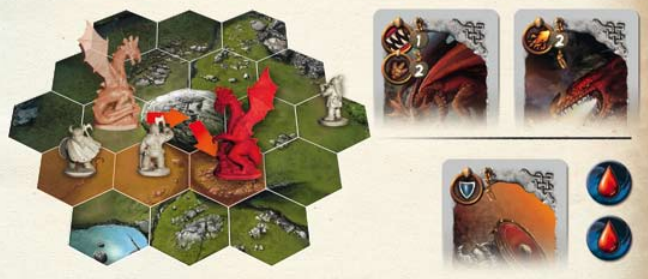
Example: Kate plays two cards in her turn. First she chooses “Move” - the dragon moves two hexes, to get into a better attack position and to get out of the archer’s hex row.
For her second card, she chooses “Fire attack”. Because 2 dwarves are standing in the line of attack, they can both be wounded. However, John has one defense card, which he uses to block the attack on one of the 2 dwarves. The other dwarf receives 2 wounds.
DRAGON PLAYER MAT AND ABILITIES
The dragon player mat has spaces for wound markers received during play. The first 4 wounds are placed on the armor spaces - these have no direct effect. Later wounds are assigned by the dwarf player to specific abilities - Flight, Movement, and Fire breathing.
After all of an ability’s spaces are wounded, the dragon cannot use that ability any more. After all of the dragon’s spaces are wounded, the dragon is defeated and the dragon player loses the game.
 |
Dragon's armor |
no direct effect. |
 |
Flight |
allows the dragon to use a card with the Flight symbol to move quickly to any empty hex on the board. |
 |
Fire breathing |
allows the dragon to use a card with the Fire attack symbol to attack all dwarves in one direction in a line of hexes. |
 |
Movement |
allows the dragon to use a card with the Move symbol to move on the board. |
Game End
The game can end in 3 ways:
- The dragon is killed - the dwarf player wins.
- The dwarves are killed - the dragon player wins.
- The dragon is still alive after the last dwarf card is played - the dragon player wins.
Author's notes:
Drako is an asymmetrical game. Playing the dragon is different from playing the dwarves. The dragon should certainly not enter battle too eagerly, as it could end badly for him. The dwarves, meanwhile, should use the power of the net and fury.
It is also important to use the cards wisely. The dwarf player must remember that he loses when his cards run out, and the dragon player must be careful not to use up his cards too early while the dwarves still have cards to play, because that is dangerous. -Adam Kałuża-